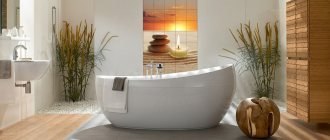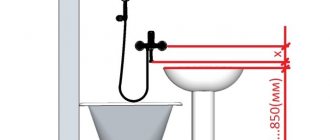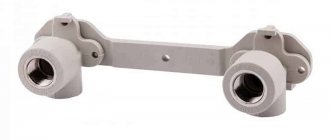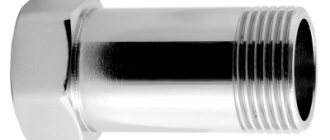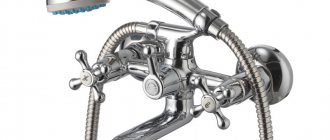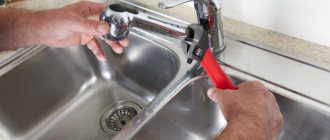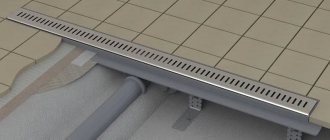Using plumbing in a bathroom or toilet should not cause discomfort to all family members. It is for this reason that before carrying out installation work, the optimal height of water outlets is determined - equipment designed for connecting plumbing fixtures to water supply and sewerage pipes. How to determine the height of device placement yourself? What parameters need to be taken into account additionally? Are there standards for the location of water outlets? The answers follow.
Equipment for connecting the mixer to the water pipe
Standards for installing a mixer in a shower
Standards for the installation of plumbing in Russia are given in SNiP 3.05.01–85 “Internal sanitary systems”. It is recommended to install bathtub faucets at a height of 120 cm from the level of the finished floor, that is, from the surface formed after laying the finishing coating. For the bathroom this means from the surface of the floor tiles.
The document recommends moving on to installing sanitary fixtures after installing pipes and sewers, but you will have to calculate the mounting height of the fixture a little earlier. Otherwise, it is not clear at what height to install the pipes. If you are not sure that the measurements were made accurately, it is better to remove the pipes with a reserve, because cutting them is much easier than extending them.
For shower mixers, the installation height recommended by SNiP is 120 cm to the bottom of the shower tray or bathtub. But it is important to remember: these rules were created not for apartments, but for showers in institutions and sports complexes. In addition, at the very beginning of the document there is an important clause - the installation of plumbing must be carried out in accordance with the requirements of not only SNiPs, but also the instructions of the manufacturers. Therefore, the main document containing the installation standards for a specific mixer is the installation and operating instructions attached to it.
What should the height of the mixer be? In practice, installation of mixers is carried out taking into account the customer’s opinion and common sense.
A mixer in a shower differs from a regular one in that it is necessary to take into account two parameters: the distance from the taps to the bottom of the bathtub and the distance between the point where the shower hose is discharged and the attachment of the shower head.
In the first case, it is difficult to talk about standards: people have different heights, some take a bath while sitting or lying down, others prefer to shower while standing. There are families with children, and there are apartments where one or two tall adults live. The comfortable height of the location of the taps that regulate the water temperature depends not only on the anthropometric data of the apartment owners, but also on the type of mixer: you cannot install a single-lever and valve or thermostatic at the same height, for the user the difference will be 15-20 cm.
Customers usually ask to install the mixer 15-30 cm above the top edge of the bathtub. This interval is convenient for most people. As for attaching the watering can, it should be at such a level that it is comfortable for each family member to stand under the shower, everyone can take the watering can, and at the same time the hose hangs freely, but does not hang into the bathtub. This way it will last much longer.
If there are children in the family, the most convenient option for attaching a watering can will be a rod. With its help, each family member will be able to attach a watering can holder according to their height for a shower.
Regulatory Requirements
Regulatory requirements for the installation of pipeline fittings in accordance with SNiP 2.04.01 clause 10.5 are given in table No. 2.
Table 2. Regulatory requirements for the installation of pipeline fittings for cold and hot water supply
|
|
|
|
|
|
|
|
|
|
|
|
|
| ||
|
| ||
|
| ||
|
| ||
|
| ||
|
| ||
|
| ||
|
| ||
|
|
| |
|
|
| |
|
|
| |
|
|
| |
|
|
| |
|
|
|
|
|
|
| |
|
|
| |
|
|
|
|
|
|
|
|
|
|
|
|
|
| ||
|
| ||
|
| ||
|
| ||
|
|
|
|
|
| ||
|
| ||
|
|
When purchasing plumbing fixtures, the presence of invisible cracks is determined by ear by tapping the product, located on a wooden stand, with a wooden hammer weighing about 250 g. A product that has cracks makes a rattling sound when tapped.
The presence of nicks and scratches is determined visually by wiping the surface of the product with a cloth soaked in a 0.1% solution of methylene blue solution. If there are nicks or scratches, they are filled with a blue solution and are detected visually without the use of magnifying devices.
What determines the installation height of the mixer?
Often, in an attempt to save money, people plan to install a single bathtub faucet and an adjacent sink. It seems that they are not used at the same time; shower mixers are often equipped with long spouts that fully reach the sink, which means that one device is enough. This is a serious mistake. Firstly, constant turning will wear out the spout faster and will require at least annual repairs or even replacement. Secondly, the installation height of the mixer in this case is calculated based on the highest object. That is, according to the washbasin, which is usually installed no lower than 85 cm from the floor along the upper edge, and as a strict norm, SNIP recommends this only when installing a single mixer on a bathtub and sink. But it still turns out that the sink is located significantly higher than the top edge of the bathtub. As a result:
- the shower mixer is too high;
- the sink has to be installed at a height convenient for people 160-165 cm tall; everyone taller will have to bend over it, overloading the lower back muscles;
- you are limited in choosing the depth of the sink and the shape of the spout;
- installation under the sink of a washing machine becomes impossible.
The dubious benefit of purchasing one faucet instead of two is offset by significant inconvenience and increased costs for plumbing repairs.
Types of mechanisms
Today there are three types of faucets: herringbone, single-lever and thermostatic. A herringbone is a pair of crane axle boxes located in one body. They are made with a ceramic disc or with a rubber gasket. Valves control water flow, pressure, and regulate temperature.
Single lever mixer
Herringbone mixer
Thermostatic mixer
When purchasing such a design, it is necessary to examine the quality of the connection of the parts: it often happens that bad installations do not completely block the water or have valves that circle in different directions without meaning. The second designs contain a pair of polymer plates or layers; the interval between them can be adjusted using a lever.
Thermostatic designs for bathtubs and showers are the most expensive; they allow you to adjust the required temperature, and this does not depend on the pressure and heat of the water. Such devices have a safety system that prevents the water from being very warm or cold.
The most reliable and reliable material for producing the body of a structure can be called brass, which is made from an alloy of copper and zinc. A galvanic layer is often placed on top of it. It is better to buy other spare parts from stainless steel - it is not heavily exposed to unnecessary sediment that accumulates in the pipes.
Recommendations for choosing the height for installing the mixer
Planning the installation height of a shower is a task that is feasible for people without engineering or even plumbing education. This device forgives minor errors during installation. But there are several rules that must be followed:
- Having planned exactly how the mixer and watering can will be fixed, before starting installation, attach the already purchased device to the wall, stand in the bathtub or shower and evaluate how convenient this arrangement of the watering can and spout is for you;
- you need to count the distance to the attachment points of the mixer and watering can from the bottom of the bathtub or cabin, the distance from the floor is an unreliable value, it depends on the height of the legs of the bathtub and the thickness of its bottom, and as a result the shower may be fixed too low, which will negatively affect your comfort;
- however, it is necessary to measure the distance to the attachment points from the floor, lower surface and bottom of the bathtub; this data will help in other work;
- do not attach the device to the joint of the tiles and especially to the tiled border, otherwise the device will not be fixed well and will not last long, and high-quality reinstallation with such initial data will not be easy;
Measure twice, cut once - this proverb accurately conveys all the nuances of installing a shower faucet. Act slowly, think through everything down to the smallest detail, follow the technology - and then the device will last a long time, the device will look neat, and replacing it when the time comes will not cause difficulties.
Bath
conclusions
Calculating the position of plumbing fixtures and auxiliary equipment, furniture and accessories in the bathroom does not necessarily have to rely entirely on statistical data and SNiP. To check whether the standard height of a bathtub from the floor with legs or the height of the faucet above the bathtub is suitable for a particular family, it is worth “estimating for yourself” the ergonomic parameters of the room and choosing the optimal placement option.
To check standard sizes, help is needed - with a tape measure or a long ruler, an assistant determines the difference between standard and individual data and selects a specific value from the proposed ranges.
How to choose
When choosing rods for curtains in the bathroom, remember that it should not only be attractive in appearance, but also practical and lightweight. For example, if you do not like extraneous noise, then plastic will be ideal, since the movement of the rings along the metal rod will create additional sounds. To prevent this from happening, it is best to choose metal rings with an additional plastic coating to attach the curtains to the rod.
The minimum service life will be ensured by telescopic rods with vacuum pressure to the surface. This design can break from the slightest careless movement or sudden opening of the curtains. Not all rods are able to withstand heavy curtain models without deformation; this is important to remember when choosing. With a large length of the rod, you cannot do without ceiling or wall fastenings, which, if desired, can be turned into room decor. When purchasing a curtain rod, you need to pay attention to some nuances:
- connecting parts should occur without difficulty;
- Each structural element must be intact, without chips or defects. The coating of the rod must also be of high quality;
- all fastenings must be made of moisture-resistant materials.
Sources:
- https://vanna-expert.ru/santekhnika/shtanga-dlya-dusha-v-vannu.html
- https://stroy-podskazka.ru/vannaya/dush/shtanga/
- https://VannayaSovety.ru
- https://FB.ru/article/241730/shtanga-dlya-dusha-v-vannuyu-foto-ustanovka
- https://vashavannaya.ru/dushevye-stojki.htm
- https://GazPribor-Tambov.ru/santehnika/kak-prikrepit-derzhatel-dlya-dusha.html
- https://gidroguru.com
- https://KrepezhInfo.ru/kreplenie-dlya-dusha/
- https://VannayaSovety.ru
- 1
Types of racks
In their appearance, design, size and additional functions, shower racks can vary greatly from each other. The choice here is practically unlimited - manufacturers take into account all possible, even minor, customer wishes, and everyone can find an option that would fit perfectly into the bathroom. Therefore, we will consider only the main, basic types of shower racks.
Shower column with rain shower and mixer tap
This shower stand can perhaps be called one of the most convenient. It is more convenient to use than a separate shower and mixer, and in addition, the entire set is made in the same design style. By the way, this option is often cheaper than varieties without a mixer.
Types of water sockets
The high popularity of the device led to the development of several of its models.
Now you can find the following types:
- Single. From the name you can understand that the connection here occurs with only one element.
- Double solid. Here the situation is the same, only you can connect two devices.
- Double, which are located on relief strips. You can also connect two devices, only the design allows you to separate the line from each other.
It is also very important to know what materials are used for production. This list included:
- Stainless steel.
- Cast iron with galvanization.
- An alloy of brass, bronze and other metals.
- Polyvinyl chlorides or polypropylenes.
Urinals actually have a number of advantages over a regular toilet.
Wall-mounted urinals require less space to install, are much easier to care for, and are easy to maintain.
Plus, they can significantly reduce your costs by consuming very little water during flushing. In fact, some urinals don't even require water to operate.
They're just as quick and efficient to use, which is probably one of the reasons why there tend to be shorter lines outside men's restrooms.
Of course, despite all the benefits that wall-mounted urinals provide, a huge portion of the population will never use them. Thus, the conventional toilet will occupy a leading position in washrooms around the world. But it's definitely worth understanding how a urinal can save you money and make cleaning your bathroom easier.
To help you learn more about urinals, we've put together a comprehensive buying guide that covers everything you need to know when considering the options available on the market.
It doesn't matter if you're buying a urinal for a commercial business or adding one to your bathroom, our guide will help you better understand the features so you can make an informed decision.
Urinal in different countries
Islamic toilet etiquette prohibits urinating while standing; people must squat or sit, which is why urinals are not used in Muslim countries.
Outdoor urinal, Holland
In some European countries (France, the Netherlands, etc.), urinals are placed openly on the streets.
Types of urinals
Before purchasing a urinal, the main thing to do is to choose the type of device that is best suited for use. Unlike toilets and bidets, urinals come in only a few varieties. To narrow down your choices, let's take a closer look at the two main options.
Urinals with flush system
The most common option is traditional urinals. They work like a standard toilet. You do your thing, and once you're done, you need to wash it off. During the draining process, water flows out and helps remove all the “liquid waste” from the bowl into the drain hole.
Due to the fact that this type of urinal is quite common, you will have quite a wide range of options to choose from. There will be a variety of urinal designs, styles, finishes and features to choose from. (Yes, urinals have their own characteristics).
The most amazing thing about a water-flushing urinal is that you won't have to repair it as often as a similar waterless unit. Although, make no mistake, they still need to be cleaned and disinfected regularly.
For most users, especially if the urinal will be used in a commercial setting, this will be the most popular device. Not only because there are many options to choose from, but also because men get a familiar feeling when using these urinals.
Let's summarize:
- this is the most common type of urinal;
- there are many options available to choose from;
- requires less attention in terms of disinfection and maintenance;
- Over time, the amount of water consumed per flush may increase.
Waterless biourinals
The waterless urinal is definitely something new. They probably pique your interest because the curious have a question: how do they remove urine without water? Let's just say it's all about the unique design.
Instead of pouring water into a bowl, a biourinal is designed to use gravity to remove all liquid waste. Like a traditional urinal or toilet, they connect to your plumbing system and don't require anything else from you.
They are becoming increasingly popular, especially for large companies and stadiums, because they can dramatically reduce the amount of water used. Not only will this save you a lot of money, but it will also be good for the environment. A win-win for everyone.
The main disadvantage of a waterless urinal is that they will have to be cleaned more often than other types of urinals and may also require regular maintenance. But for many entrepreneurs, the savings and environmental benefits are worth it.
Device and parameters
Often, a urinal is a compact design, with small dimensions compared to a traditional toilet, which allows it to be used in a wide variety of interiors. This item is made from plumbing faience or stainless steel; sometimes there are metal models covered with colored enamel, less often – plastic ones.
The installation of this type of plumbing fixture is quite simple. The entire structure includes:
- actually, the cup itself;
- faucet (valve) or flush button;
- siphon for drainage and blocking unpleasant odors from the sewer system;
- set of fasteners for wall installation.
An ordinary men's urinal with wall mounting has dimensions of 800 x 425 x 365 mm (H x W x D). However, depending on the style of the interior, the dimensions of the sanitary room, the design features of the item itself and other conditions, the dimensions may deviate from the specified norm.
